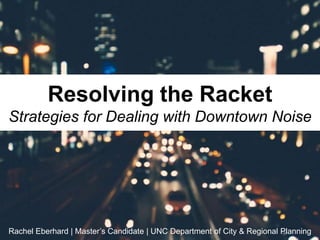FINAL - Resolving the Racket
- 1. Resolving the Racket Strategies for Dealing with Downtown Noise Rachel Eberhard | Master¡¯s Candidate | UNC Department of City & Regional Planning
- 4. Glenwood South Hospitality District Permit & Complaint Process Business Contact Time & Sound Limitations
- 8. Rachel Eberhard Master¡¯s Candidate, 2016 The University of North Carolina at Chapel Hill Department of City & Regional Planning Contact: eberhard.rachel@gmail.com
Editor's Notes
- #2: Introduction & origin of project (Development & Environmental Management class) Discuss noise as a development concern, the recent pilot program in Raleigh & look at two other cities that are dealing with similar problems in different ways
- #3: Commercial operations can enhance the vitality & culture of urban areas¡ªbut they can also create noise problems USA Today Poll: Noise is the most common neighbor dispute Often related to ¡°reverse sensitivity¡± & conflict between incompatible activities Reverse sensitivity describes the effect that development of one kind may have on activities already occurring in an area Balance must be achieved between providing for legitimate commercial activities while controlling potential adverse noise effects to reasonable levels
- #5: Established in an attempt to address concerns that the outdoor amplification noise permits adversely impacting surrounding residences The one-year pilot is scheduled to run through November 2015 PERMIT Hospitality District Entertainment permits will replace Amplified Entertainment and Outdoor Amplified Entertainment permits Mediation process & escalation BIZ CONTACT Also outlines a new approach to resolving complaints Interactive map provides contact information for permit holders Allowing for direct communication with the business TIME & SOUND LIMITATIONS Provides guidelines for outdoor noise levels Adjustment made to accommodate venue hours (Fri-Sat, 11PM to 2AM) at 60dBA
- #6: Experiencing rapid growth; vibrant music scene Gained reputation over time as ¡°Dirty 6th¡± Mecca for bachelor parties, rowdy crowds & difficult venue owners The difficult is that Alcohol Beverage Control controls what goes on inside, but the city has to deal with what happens outside Staggered closing hours Assigning a set number of police officers to patrol area Ordinance revision to address low-frequency sound (bass) Outdoor Music Venue (OMV) permitting Aiming to change the behavior Consequences for bad actors
- #7: During 1980s, the revitalization of downtown Denver started with nightlife & dining options Increased public development (museums, theatres, parks, etc.) led to more private development Challenges soon included quelling violence, drug activity & noise from the late night bar crowd LoDo Neighborhood Association Good Neighbor Agreements Street blockades for vehicles Off-duty officer support & training Police officers hired by LoDo District, Inc. ¡°The Drunk Tank¡±
- #8: REGULATORY Zoning, ordinances, regulations, etc. Staggered bar closures Liquor licensing ? PARTNERSHIPS Coalitions with residents, businesses, landlords, etc. Closely monitor permits for events Cleanliness & maintenance to sidewalks/storefronts ? EXTERNAL EFFECTS Work to attract high-quality tenants The city purchasing property ? economic development strategy Need to understand the benefits to achieve buy-in (local musicians, restaurateurs, etc.) ? ACOUSTIC DESIGN Architectural & building acoustics (absorptive materials) Environmental acoustics (waterfalls, green space & vegetation) FINAL THOUGHTS Noise ordinances are very difficult to enforce Neighborhood organization, the police department, and downtown development organization must work together to deal with establishing & maintaining a standard Residential development is critical for downtown success Raleigh¡¯s nightlife challenges are good ones to have¡ªit means people are flocking to downtown from outside of the city The more mixed use, the better BOTTOM LINE: Strong coalition & partnership are a MUST
- #9: Thank You & Contact Information








